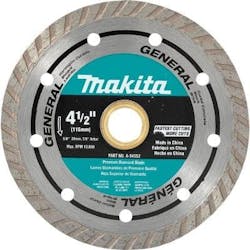(Nearly) Everything You Need to Know About Diamond Blades
Understanding Diamond Blades is the Key to Realizing Their Value
Ed's Note: This comprehensive tool review is reprinted with permission from ProToolReviews.com, a comprehensive tool review website, as the name infers. If you are a tool junkie, you should go there and dig through their ditches. There's a lot.
When building structures have to withstand the toughest elements, most tradesmen use concrete because it is versatile, durable, and economical. Concrete can be easily shaped and colored, and it is one of the safest building materials available.
Concrete construction has been common practice since the Roman Empire. As a testament to concrete’s strength, the Coliseum still stands today, but it also took eight years to build. Today, concrete remains one of the world’s leading building materials, but structures must be completed on tight schedules and budgets.
When working with something so strong and durable, it is equally important that craftsmen be equipped with the best tools to make their work as effortless, efficient and, safe as possible.
Whether sawing contraction joints, custom cutting decorative pavers, or making precision cuts in existing concrete, a top-quality saw blade is mandatory.
Diamond saw blades offer distinct advantages over abrasive wheels when it comes to making clean, professional cuts in concrete.
Nuts & Bolts — Typical Components of Diamond Blades
There are four typical components in a diamond saw blade:
Diamond crystals — Typically synthetic rather than natural, diamond crystals allow manufacturers to control the shape and size. The synthetic process also allows for engineering crystals for specific applications. Cutting performance is determined by the type, shape, and size of these diamond crystals.
Metal Bond — The diamond crystals are held in place by a formulated mixture of various metals which determine the rate at which the diamond crystals are exposed. A harder bond reduces diamond erosion, which is designed for softer applications like green concrete or asphalt. A softer bond increases diamond erosion and is better suited for harder material such as granite or cured concrete.
Diamond Edge — The diamond crystals and bonding matrix are heated, shaped, and attached to the blade core. This edge can have one of three configurations: segmented, continuous rim, or serrated. In each case, the diamond edge is wider than the blade’s core to reduce drag on the blade itself, increase material waste removal, and decrease the chance of blade binding within the material. These edges are affixed to the steel core through either a brazing, sintering, or laser welding process.
Steel core — The blade’s core is made from high alloy, heat-treated steel. The core is tensioned to allow the blade to turn true to course on the arbor hole, which is perfectly centered in the core.
The core is also tensioned or tuned to reduce stress caused by the high centripetal force and impact caused by cutting such dense materials.
How Diamond Blades Work
Unlike most other blades, diamond blades don’t cut the material. Instead, they use friction created between the diamond-bonding matrix and the material being cut to work like a grinding wheel.
As mentioned in the Metal Bond explanation, harder materials are best cut when the bond is softer. As the diamond particles are dulled and broken, the bond releases so that more of the synthetic diamond can be exposed.
The reverse is true for cutting softer materials. The bond is stronger to ensure that the diamond is exposed long enough to be fully utilized.
Segmented Diamond Blades vs Continuous Rim Blades
We added this section to the article after reader posed the question of when to use segmented blades versus continuous rim blades. The answer is that it depends a number of variables, including the material being cut, the speed of the cut, the finish quality, and availability of water. Segmented blades are generally used in dry cutting operations. Each segment is separated by slots or gullets. These areas serve important functions—namely, heat dissipation and debris removal. Because of this, you typically also see faster cutting speeds. Continuous rim blades are wet cutting blades that operate very slowly (relatively speaking) but provide the cleanest cuts. This is important when working with very brittle materials or when the cut edge will be exposed. Both blades are suitable for cutting concrete, masonry, pavers and the like.
Using Diamond Blades with Steel
One additional consideration is when using diamond blades on concrete with steel in it. Rebar is the backbone of concrete construction and the bane of bits and blades alike. If cutting rebar when exposed, a diamond blade will make quick work of the cut, but it greatly reduces the life of the blade. This is because diamond blades “cut” by grinding the material as opposed to other blades that rip and tear. When cutting concrete where rebar is sure to be found, it is often best to use a continuous rim blade with a supply of water.
Types of Cuts with Diamond Blades
There are two primary methods of cutting with diamond blades, wet and dry cutting. As with all blades, one factor that severely affects the blade’s performance is heat — which can lead to segment loss, core warpage and cracking, and the need for a new blade.
That is why most diamond blades utilize water to dissipate heat and increase the longevity of the blade. Additionally, the water helps keeps the dangerous dust that, when cutting concrete, contains silica. OSHA has numerous regulations restricting the amount of dust created when cutting.
Dry cutting is used less often and generally for small jobs such as cutting paver stones and should only be done outdoors.
According to M.K. Morse, a manufacturer of diamond blades, “Dry cutting blades require sufficient airflow about the blade to prevent overheating of the steel core. This is best accomplished by shallow, intermittent cuts of the material along with periods of “free-spinning” for several seconds to maximize the cooling process.”
The main difference is the way the diamond matrix is attached to the core. Wet blades are brazed, while dry blades are generally laser welded. Laser welding has a higher melting point. Aside from the weld, another difference is the bond. Dry blades usually have a slightly softer bond to allow easier cutting without water to cool and lubricate the cut.
Diamond Blade Sizes, Tools and Costs
Diamond blades come in a variety of sizes from 4” for use with angle grinders and go up to 36”. Think about those walk-behind saws you see when crews are cutting up the roads or sidewalks — they’re using diamond blades.
Diamond blades are very expensive when compared to abrasive wheels. While the initial cost is enough to scare off some purchases, what is important is the cost per cut.
Abrasive wheels have a very short life span and are not effective when cutting harder materials. Users will use consume up to 50 times more abrasives than diamond blades.
In the end, diamond blades are a very effective tool that can make short work of even the toughest materials and, since they have a long shelf life, the initial investment will pay off in the end.
—This article is reprinted with permission from ProToolReviews.com, an excellent source of tool reviews (as the name implies). Rob Foster, a contributor to ProToolReviews wrote this piece.





